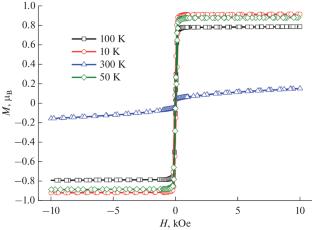利用电子自旋共振测量 Fe1.1Ga0.9O3 的合成和磁性能
IF 0.48
Q4 Physics and Astronomy
Bulletin of the Russian Academy of Sciences: Physics
Pub Date : 2024-08-19
DOI:10.1134/S1062873824707220
引用次数: 0
摘要
摘要 作者研究了在基于 Bi2Mo3O12-Na2B4O7 的多组分通量体系中铁-镓氧化物和铁-镓-铜硼酸盐晶体的形成。根据电子自旋共振 (ESR) 光谱和 Fe1.1Ga0.9O3 单晶体的磁化率(取决于温度),确定了居里-魏斯温度(θCW = 289 K)和铁磁体-准磁体相变温度(TC = 288 K)。在有序相的磁共振谱中可以观察到自旋波共振线。本文章由计算机程序翻译,如有差异,请以英文原文为准。


Synthesis and Magnetic Properties of Fe1.1Ga0.9O3, Measured According to Electron Spin Resonance
The authors study the formation of crystals of Fe-Ga oxides and Fe–Ga–Cu borates in a multicomponent flux system based on Bi2Mo3O12–Na2B4O7. The Curie–Weiss temperature (θCW = 289 K) and the temperature of the ferrimagnet–paramagnet phase transition (TC = 288 K) are determined from the electron spin resonance (ESR) spectrum and the magnetization of an Fe1.1Ga0.9O3 single crystal, depending on temperature. Lines of spin-wave resonance are observed in the spectrum of magnetic resonance in the ordered phase.
求助全文
通过发布文献求助,成功后即可免费获取论文全文。
去求助
来源期刊

Bulletin of the Russian Academy of Sciences: Physics
Physics and Astronomy-Physics and Astronomy (all)
CiteScore
0.90
自引率
0.00%
发文量
251
期刊介绍:
Bulletin of the Russian Academy of Sciences: Physics is an international peer reviewed journal published with the participation of the Russian Academy of Sciences. It presents full-text articles (regular, letters to the editor, reviews) with the most recent results in miscellaneous fields of physics and astronomy: nuclear physics, cosmic rays, condensed matter physics, plasma physics, optics and photonics, nanotechnologies, solar and astrophysics, physical applications in material sciences, life sciences, etc. Bulletin of the Russian Academy of Sciences: Physics focuses on the most relevant multidisciplinary topics in natural sciences, both fundamental and applied. Manuscripts can be submitted in Russian and English languages and are subject to peer review. Accepted articles are usually combined in thematic issues on certain topics according to the journal editorial policy. Authors featured in the journal represent renowned scientific laboratories and institutes from different countries, including large international collaborations. There are globally recognized researchers among the authors: Nobel laureates and recipients of other awards, and members of national academies of sciences and international scientific societies.
 求助内容:
求助内容: 应助结果提醒方式:
应助结果提醒方式:


